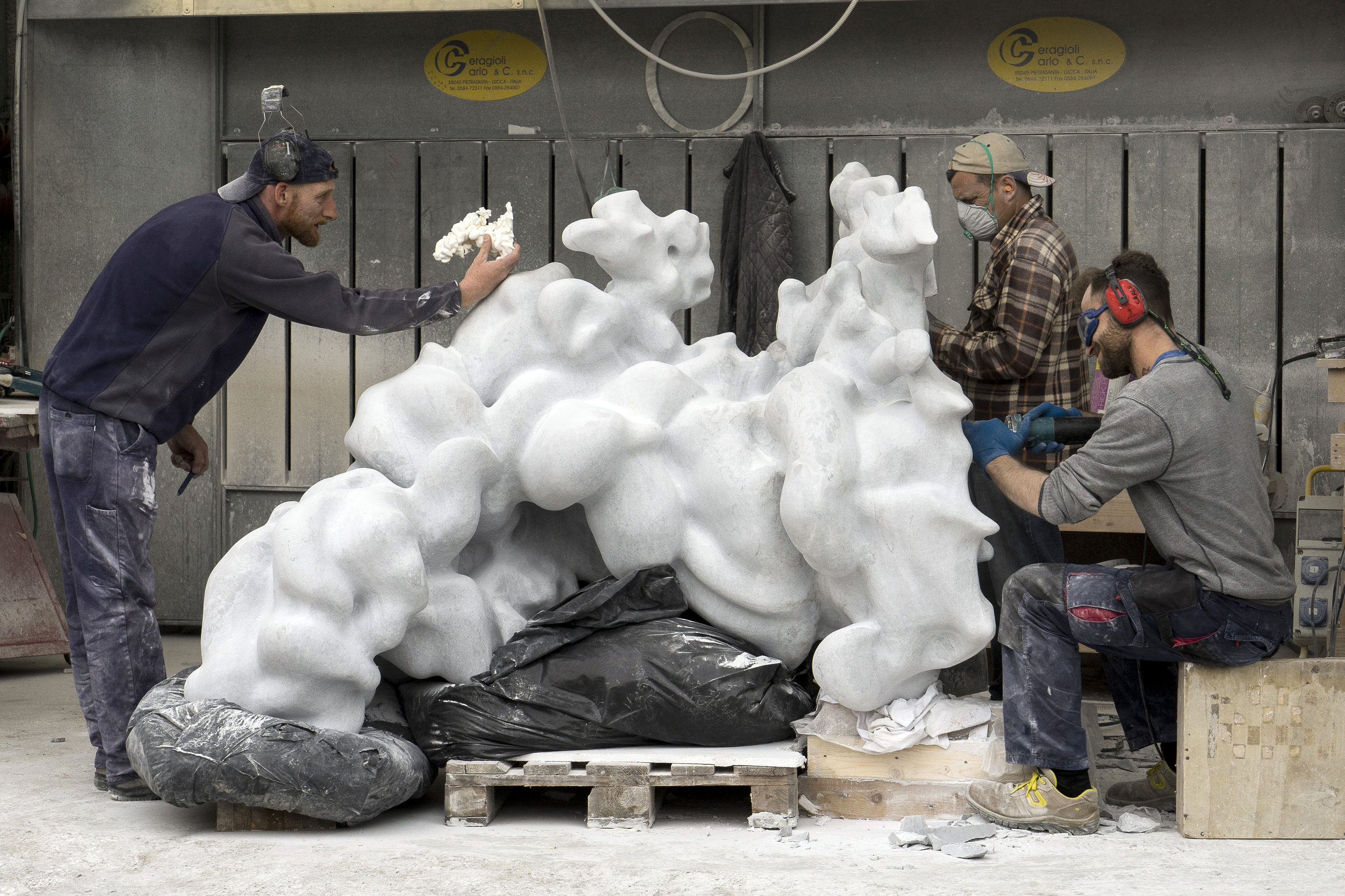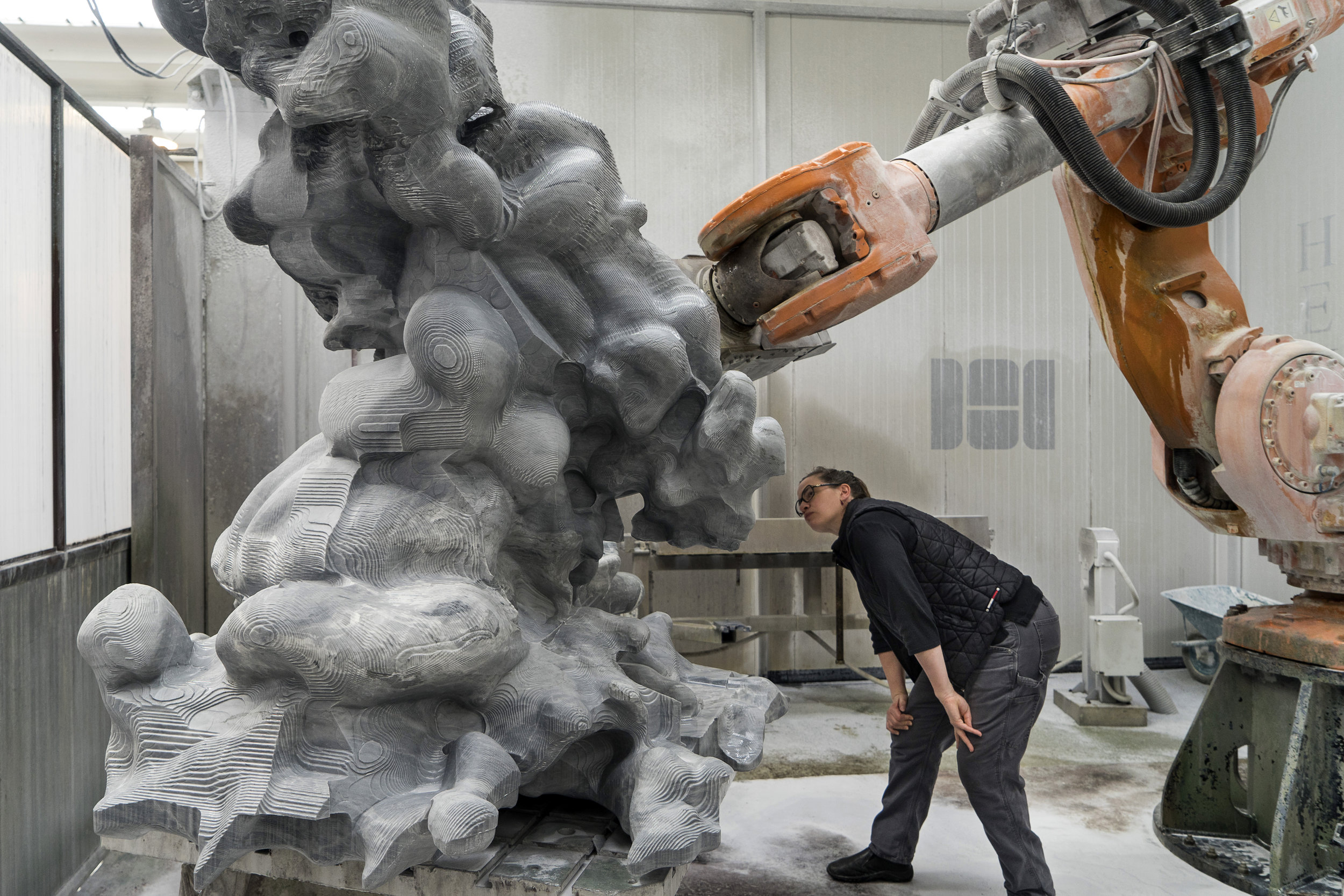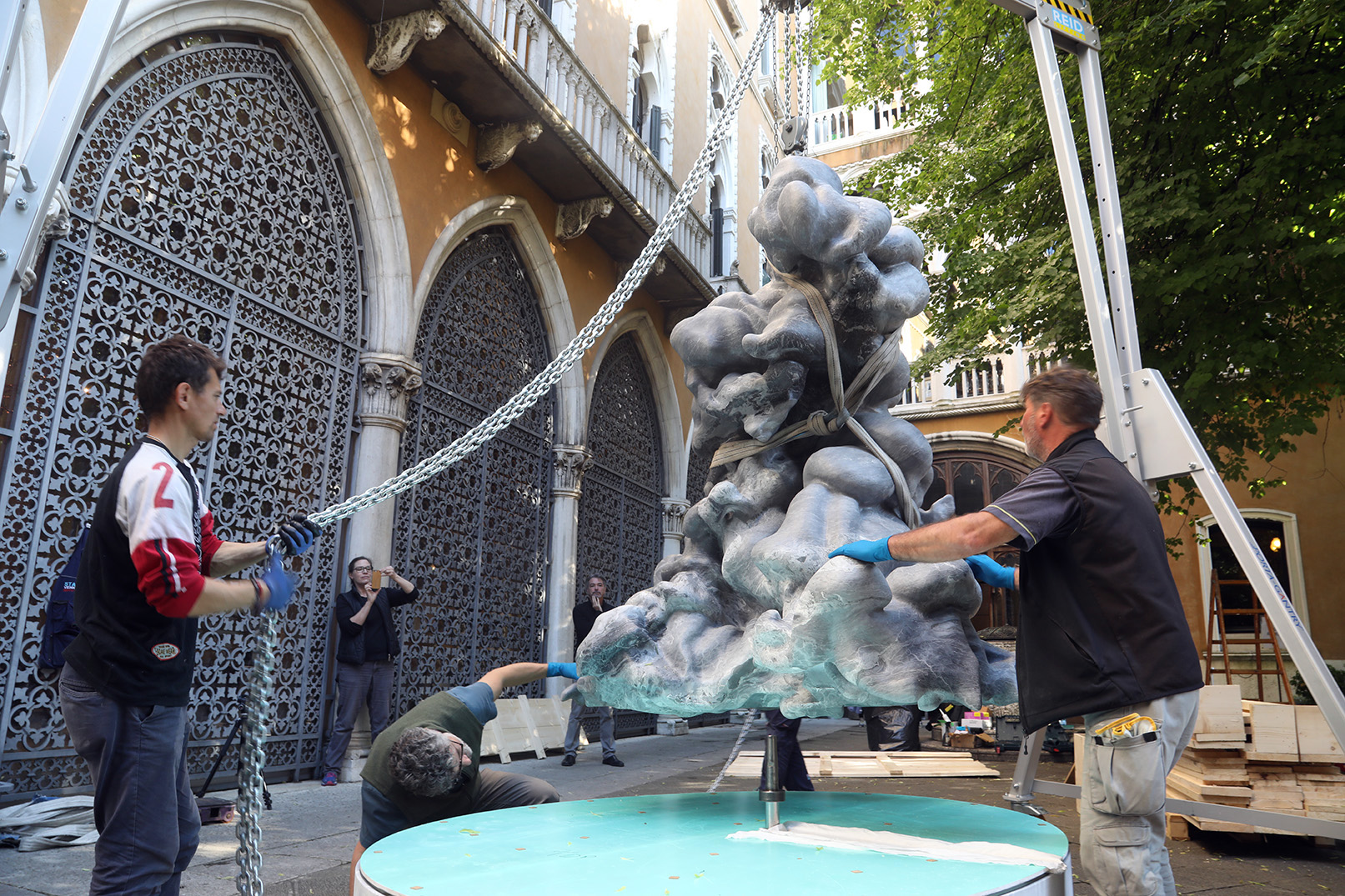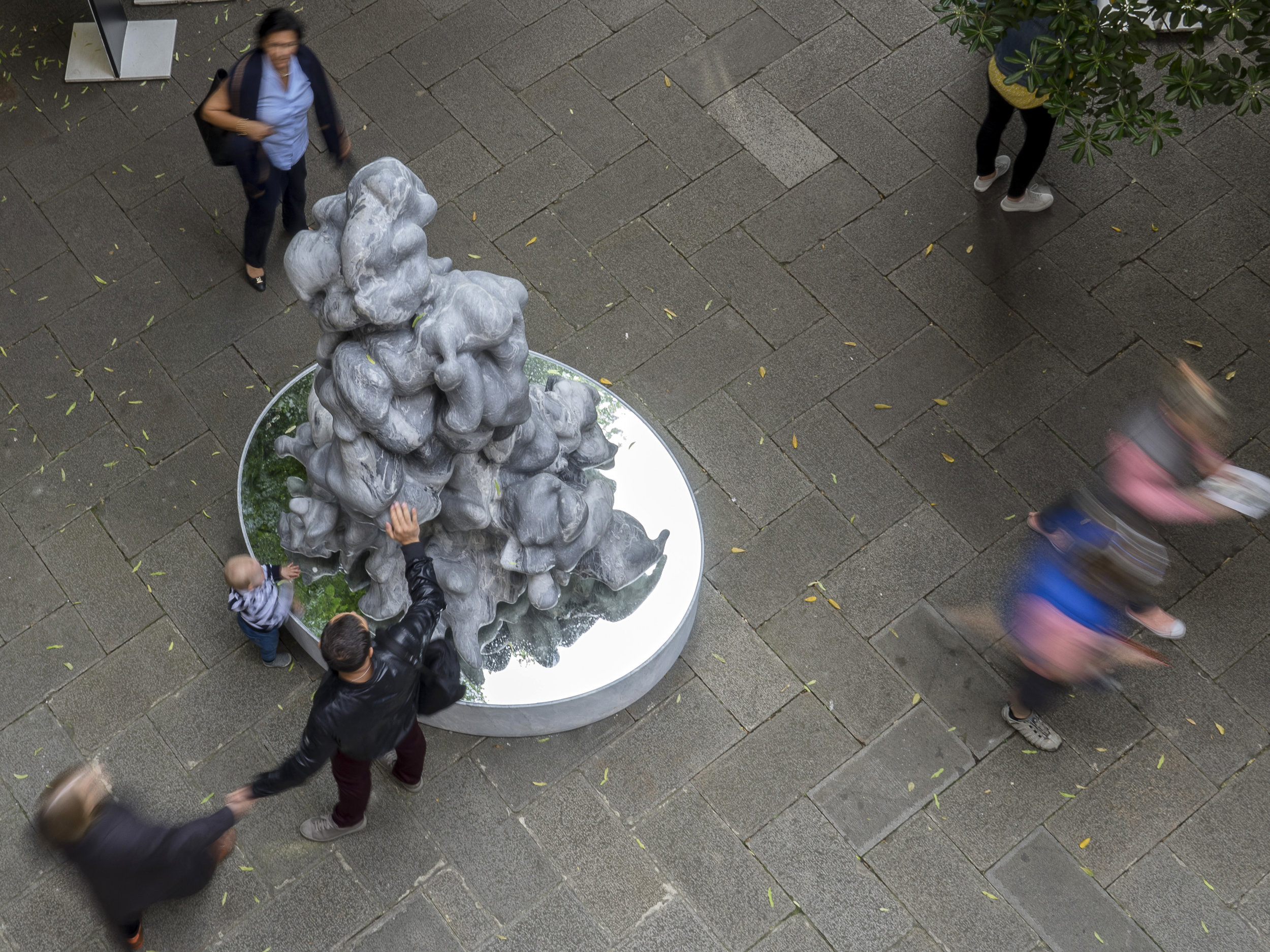Cloud Sourcing
Caltech climate scientists help bring an artist's cloudy vision to life.
How much does a cloud weigh? That was the question on Karen LaMonte's mind when she emailed Caltech climate scientist Tapio Schneider a year and a half ago. LaMonte—an artist who lives in Prague and is known for monumental sculptures in ceramic, bronze, and glass—had long been fascinated by clouds and now sought to use them as a canvas for her artistic imagination.
Artist Karen LaMonte’s 7-foot-tall, 2.5-ton sculpture Cumulus, now on display in Venice, was carved by robots and finished by hand. In the slideshow above, LaMonte can be seen inspecting her work in the photo with the large robotic arm. Photo: Nicola Gnesi
LaMonte had in mind a cloud sculpture—but with a twist. Her plan was to find a cloud to use as a model for her artwork and make the sculpture's weight equivalent to the original cloud.
"What struck me," says LaMonte, "was the fascinating and completely unexpected weight of clouds. We see them floating in the air. We think of them as fluffy cotton balls, like helium balloons. But when you learn a bit more, you realize they're actually amazingly heavy. I thought, wouldn't it be amazing if we could get a 'real' cloud and carve it in marble?"
LaMonte had already been contacted by an Italian foundation about including her Nocturne sculptures in an exhibit during the 2017 Venice Biennale, a major international art show that takes over the Italian city every other year. When she told members of the foundation about the cloud project, their interest was piqued and they agreed to include that work also. "The Biennale timeline moved the deadline way up," says LaMonte, who now had extra motivation to translate her vision into reality in a timely fashion.
Schneider, the Frank J. Gilloon Professor of Environmental Science and Engineering, who also has a joint appointment with JPL, was intrigued when he received LaMonte's email.
"I thought it was a great idea," says Schneider, whose work focuses on reducing uncertainties in climate change projections—in part through modeling cloud formation to better understand clouds' impact on the environment. Collaborating with LaMonte, he reasoned, could help raise awareness of these issues. "Clouds are hugely important for the climate," says Schneider. "How much warmer it will get depends on what happens to cumulus clouds like those Karen was interested in. We don't have a very good idea of that right now, and that’s what my group's research is about."
Observations of clouds with enough three-dimensional detail to translate into a sculpture are not available, but the equations governing clouds are known, and so the structure of clouds can be computed. Caltech research scientist Kyle Pressel, who is part of Schneider's group, worked closely with LaMonte to produce the cloud simulation from which she would create her sculpture. Over a period of five days, using a supercomputer located in a facility on the shores of Lake Lugano in Switzerland, Pressel and Schneider undertook one of the larger cloud simulations they had attempted.
Their goal: model conditions that would create a cumulus cloud worthy of sculpting. To do so, they modeled their simulation on conditions that occurred during the Barbados Oceanographic and Meteorological Experiment, conducted in the summer of 1969. The result? "A classic cumulus you'd see while lying on a beach in Barbados," says Pressel, "a postcard Caribbean cumulus." Or, in reality, a triangulation of the surface of such a cloud.
As enthusiastic as the scientists were about the project, they admit that it presented unusual challenges. "Typically, in the work we do, we're most interested in the statistics of clouds," says Pressel. "What we had to do here is figure out how to describe the 3-D surface of a cloud. Karen was very good at dealing with the data sets we provided; all I had to do was define the edges of the cloud—where there's liquid water, there's cloud; and where there isn’t, there's not."
To transform the virtual cloud model from Schneider and Pressel into an actual sculpture, LaMonte again turned to technology. "It would have been very challenging for a human to carve that shape," she says of the complex billowing form. "Also, to really nail the weight equivalency, I needed a software program and a physical robot."
Carving marble, says LaMonte, has always been a challenging task, and over the centuries artists have come up with innovative solutions. "Rarely does someone just start chipping away in stone. Think about Michelangelo; he submerged his wax model of David in water, exposing it layer by layer and carving the marble to match the emerging figure. Three hundred years later, Antonio Canova perfected the pointing machine to transfer exact points from a model onto marble, followed by Benjamin Cheverton’s patented 3-D pantograph."
LaMonte adds, "Only by using technology could I make the diaphanous solid and the intangible permanent."
It took the robots four weeks of carving and LaMonte an additional four weeks of hand-finishing before the 15-ton block of marble she had previously picked out from a quarry in the mountains of Italy assumed its final form as Cumulus, a 7-foot-tall, 2.5-ton sculpture on exhibit outside Venice's Palazzo Cavalli-Franchetti through November 26, 2017.
Since much of LaMonte's earlier work has been focused on the human figure, some might see Cumulus as a departure. But the artist only sees a correlation. "One of the things that always drew me to figurative work," she says, "was that I wanted to make something universally expressive and readable to the end viewer." In clouds, she found just that. "Anytime, anywhere on the globe, somebody could be standing and looking at clouds. They are indeterminate and ever changing, a perfect receptacle for the mind's ruminations and the ebb and flow of emotion."
Clouds are also anthropomorphic, suggesting all manner of creatures to the observer's eye. "My cloud is baroque in its physicality," says LaMonte. "It looks like folds of fabric or flesh tumbling through space."
Schneider, who studies the science of clouds, well understands their aesthetic appeal as well. "As a kid, I wanted to touch the clouds, and people can't keep their hands off the sculpture," he says. "Clouds are beautiful, fun to look at, and important for our future."




